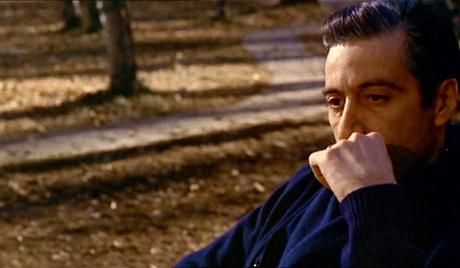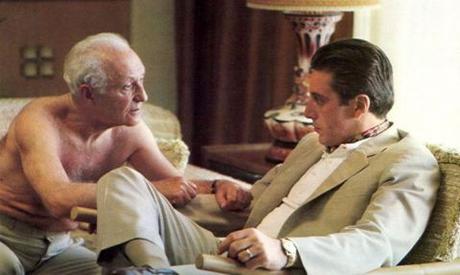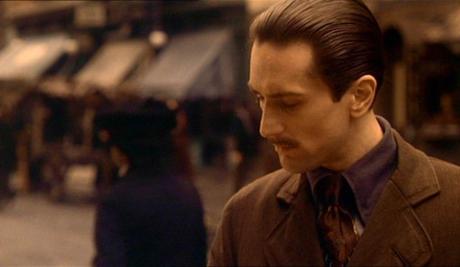 Al Pacino as Michael Corleone in The Godfather Part II (Paramount Pictures)
Al Pacino as Michael Corleone in The Godfather Part II (Paramount Pictures)At three hours and twenty minutes, The Godfather, Part II is almost as long as David O. Selznick’s Gone with the Wind, but not nearly as funny. Taking his cue from the financial juggernaut the first film went on to become, director Francis Ford Coppola decided that a sequel to Paramount’s tremendously successful The Godfather should be more of “a companion piece,” with flashbacks to the early life of young Vito Corleone and fast-forwards to the new/old godfather, i.e., his son Michael.
As a consequence, Coppola’s triumphant continuation of Mario Puzo’s The Godfather saga is more than just excessive padding: it looks backward in time to the story of the orphaned Vito Andolini, who flees a violence ridden Sicily and a blood feud with the local Mafia don to come to New York City at the turn of the century. The boy Vito winds up on Ellis Island, where his surname is changed to Corleone by the immigration officers. He grows up in poverty on Manhattan’s Lower East Side and eventually settles down with a pretty Sicilian girl to have a family of his own.
During one of several flashback sequences, which comprise three-quarters of an hour of the movie’s total length, we learn how Vito faces down the dreaded Don Fanucci (played in oily fashion by the formidable Gaston Moschin) in order to take control of his life and neighborhood. It’s at this crucial point in the drama that Vito (as well as the viewer) realizes he is able to carry out Fanucci’s murder in methodical, calculatedly cold-blooded fashion. The hood’s death solidifies Vito’s standing in the Italian community as a person to be feared, which ultimately leads to his becoming a “respected” member of underworld society.
We then flash forward to the dawn of a new don, Michael Corleone (an intensely driven Al Pacino, never better), and his round-the-clock efforts to salvage his family’s Nevada holdings from the clutches of a soft-spoken yet ruthless gangster named Hyman Roth (Actor’s Studio co-founder Lee Strasberg in his movie debut, and one of Pacino’s early mentors), who has one of this picture’s best remembered lines: “Michael, we’re bigger than US Steel.” At the same time, Michael has to simultaneously confront the possibility of a traitor in his midst, as well as deal with his failed marriage to perpetually skeptical wife Kay (the returning Diane Keaton).

Every scene is a comment on, and a ruminative reflection of, comparable ones to be found in The Godfather. Take, for instance, the opening first communion ceremony for Michael’s son Anthony, juxtaposed against sister Connie’s wedding in Part I; or how about the botched strangling of Frankie Pentangeli inside the Rosato brothers’ bar, as compared to Luca Brasi’s death by choking in a similar fashion in the presence of Sollozzo and Bruno Tattaglia’s establishment. We could go on and on, but the point has been made: this is one of Hollywood’s most provocative and, you’ll pardon the expression, best executed modern gangster epics.
Among the difficulties the main characters encounter are outright lies, blatant betrayals, family treachery, duplicity, and double- and triple-crossings, with enough chokings, drownings, stabbings, and garrotings to fill ten crime novels! There is spellbinding direction by Coppola which never flags, not even for a moment. High production values are maintained from the first feature, thanks to returning production designer Dean Tavoularis, art director Angelo Graham, costume designer Theadora Van Runkle, and expert sound montage and re-recording by Walter Murch. In addition, the hiring of a supremely talented cast make Part II that rarity of movie sequels – damned if it isn’t better than the original, in spite of more than a few lapses in narrative logic (what’s the story with those Rosato brothers, anyway?).
And speaking of the cast, the sequel spotlights a gallery of richly detailed performances, in particular one by the dour Robert Duvall as world weary consigliere Tom Hagen, struggling to understand Michael’s secretive ways; Talia Shire (Francis Coppola’s sister in real life) as Michael’s baby sister Connie, who makes a spectacle of herself with new boyfriend Merle Johnson (the real name of actor Troy Donahue, as Merle) at her nephew Anthony’s first communion; John Cazale (suave, in a black mustache and tux) as older brother Fredo and his shady dealings with Roth’s Sicilian “messenger boy,” Johnny Ola (Dominic Chianese), receiving the kiss of death from Michael for his troubles; and the stoic Robert De Niro, excellent as young Vito Corleone, who copied Marlon Brando’s mannerisms and hoarse vocalization, while picking up an Academy Award for Best Supporting Actor in the process (and, no, he did not turn Oscar down).

Others in the huge supporting cast include playwright-turned-actor Michael V. Gazzo (A Hatful of Rain) in a standout performance as old-timer Pentangeli, whose demise in a Roman-style bathtub is just one of many so-called highlights. Gazzo’s role was “invented,” to coin a phrase, by the screenwriters due to the producers dropping Richard Castellano from the film — his salary demands simply couldn’t be met and proved more of a hindrance than a benefit. Instead, we have Irish-Italian actor B. Kirby Jr. (City Slickers, Good Morning Vietnam) as a slimmed-down version of the youthful Pete Clemenza, along with G.D. Spradlin as the garrulous Senator Geary (who gets his comeuppance for badmouthing Michael’s “family”), Richard Bright returning as Al Neri, Joe Spinell as Willy Cicci, and Morgana King, Leopoldo Trieste, Amerigo Tot, Fay Spain, Abe Vigoda, Gianni Russo, James Caan, the incomparable Harry Dean Stanton as an FBI man, Danny Aiello as Tony Rosato, and Peter Donat as Senator Questadt.
Veteran director Roger Corman puts in another of his patented “guest shots” as a member of the investigating committee looking into Michael’s Cosa Nostra connections. Gordon Willis’ dark-hued photography is back, along with Nino Rota’s lush score, supplemented in part by Carmine Coppola, the director’s father, who incorporated a delightfully quaint Neapolitan light opera, Senza Mamma, into the sonic mix. This being a Coppola family gathering, the score for this little divertissement was written by (you guessed it) the director’s maternal grandfather, Francesco Pennino.
The entire Senza Mamma sequence involves a 30-something Vito Corleone enjoying a rare night on the town with best friend Genco Abbandando (Frank Sivero), by watching a performance, in authentic Neapolitan dialect, of a local melodrama in a crowded theater. The part of the singer, who holds a pistol to his forehead threatening to shoot himself at the news of his mother’s passing, was sung and acted by tenor Livio Giorgi. As a footnote to this scene, the backstage manager was interpreted by none other than Metropolitan Opera basso Ezio Flagello.
A five-star family affair, to be certain. Would we lie to you?
Copyright © 2015 by Josmar F. Lopes

